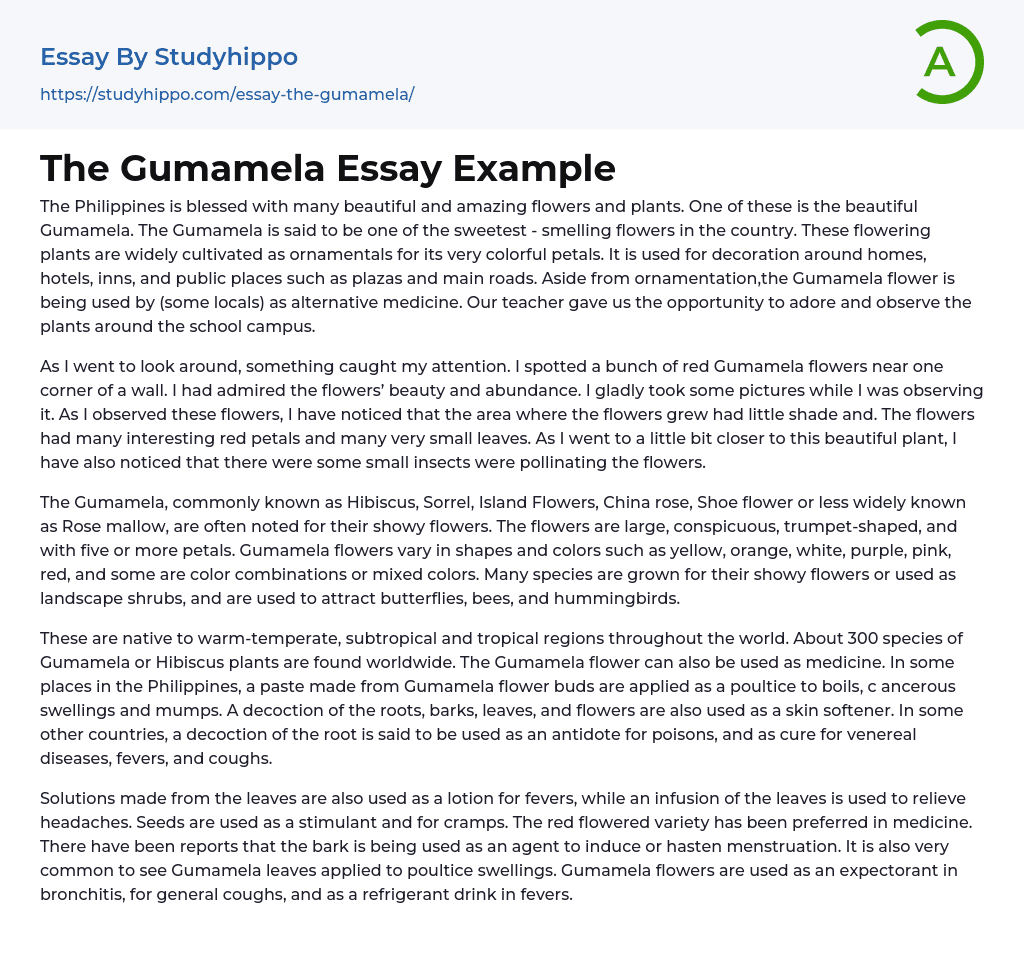The Philippines is blessed with many beautiful and amazing flowers and plants. One of these is the beautiful Gumamela. The Gumamela is said to be one of the sweetest - smelling flowers in the country. These flowering plants are widely cultivated as ornamentals for its very colorful petals. It is used for decoration around homes, hotels, inns, and public places such as plazas and main roads. Aside from ornamentation,the Gumamela flower is being used by (some locals) as alternative medicine. Our teacher gave us the opportunity to adore and observe the plants around the school campus.
As I went to look around, something caught my attention. I spotted a bunch of red Gumamela flowers near one corner of a wall. I had admired the flowers’ beauty and abundance. I gladly took some pict
...ures while I was observing it. As I observed these flowers, I have noticed that the area where the flowers grew had little shade and. The flowers had many interesting red petals and many very small leaves. As I went to a little bit closer to this beautiful plant, I have also noticed that there were some small insects were pollinating the flowers.
The Gumamela, commonly known as Hibiscus, Sorrel, Island Flowers, China rose, Shoe flower or less widely known as Rose mallow, are often noted for their showy flowers. The flowers are large, conspicuous, trumpet-shaped, and with five or more petals. Gumamela flowers vary in shapes and colors such as yellow, orange, white, purple, pink, red, and some are color combinations or mixed colors. Many species are grown for their showy flowers or used as landscape shrubs, and
are used to attract butterflies, bees, and hummingbirds.
These are native to warm-temperate, subtropical and tropical regions throughout the world. About 300 species of Gumamela or Hibiscus plants are found worldwide. The Gumamela flower can also be used as medicine. In some places in the Philippines, a paste made from Gumamela flower buds are applied as a poultice to boils, c ancerous swellings and mumps. A decoction of the roots, barks, leaves, and flowers are also used as a skin softener. In some other countries, a decoction of the root is said to be used as an antidote for poisons, and as cure for venereal diseases, fevers, and coughs.
Solutions made from the leaves are also used as a lotion for fevers, while an infusion of the leaves is used to relieve headaches. Seeds are used as a stimulant and for cramps. The red flowered variety has been preferred in medicine. There have been reports that the bark is being used as an agent to induce or hasten menstruation. It is also very common to see Gumamela leaves applied to poultice swellings. Gumamela flowers are used as an expectorant in bronchitis, for general coughs, and as a refrigerant drink in fevers.
- Food Safety essays
- Food Security essays
- Beverages essays
- Cuisines essays
- Dairy essays
- Desserts essays
- Fast Food essays
- Bread essays
- Meal essays
- Meat essays
- Organic Food essays
- Rice essays
- Sugar essays
- Taste essays
- Beef essays
- Coconut essays
- Crowd essays
- Dinner essays
- Juice essays
- Sainsbury essays
- Cooking essays
- Ginger essays
- Oreo essays
- Drink essays
- Beer essays
- Wine essays
- Coffee essays
- Tea essays
- Cake essays
- Hamburger essays
- Ice Cream essays
- Burger essays
- Pizza essays
- Fruit essays
- Lemon essays
- Food Waste essays
- Favorite Food essays
- Alcoholic essays
- Soft Drinks essays
- Cookie essays
- Starch essays
- Yeast essays
- Cola essays
- Pizza Hut essays
- snack foods essays
- chips essays
- Biscuit essays
- Brewing essays
- Brewery essays
- Anorexia essays




